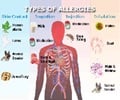
‘Sesame allergy is a common phenomenon which affects a notable percentage of people throughout the united states.’
Read More..Tweet it Now
The study provides current estimates of the prevalence, severity, distribution, and clinical characteristics of sesame allergy in the United States.Read More..
This cross-sectional study assessed the findings of the web- and telephone-based food allergy questionnaires. Study participants were first recruited from NORC (National Opinion Research Center) at the University of Chicago’s probability-based AmeriSpeak panel, and additional participants were recruited through Survey Sampling International. Surveys were administered to a nationally representative sample of 51 819 US households from October 1, 2015, through September 31, 2016. Responses for 40 453 adults and 38 408 children were included in the analysis. Data were analyzed from January 1, 2017, through May 1, 2019.
Self-reported sesame allergy was the main outcome and was considered convincing if reported symptoms to sesame-allergic reactions were consistent with an IgE-mediated reaction. Diagnostic history of specific allergens and use of food allergy-related health care services were also primary outcomes.
Using survey responses from 78 851 individuals, an estimated 0.49% (95% CI, 0.40%-0.58%) of the US population reported a current sesame allergy, whereas 0.23% (95% CI, 0.19%-0.28%) met symptom-report criteria for convincing IgE-mediated allergy. An additional 0.11% (95% CI, 0.08%-0.16%) had a sesame allergy reported as physician-diagnosed but did not report reactions fulfilling survey-specified convincing reaction symptoms. Among individuals with convincing IgE-mediated sesame allergy, an estimated 23.6% (95% CI, 16.9%-32.0%) to 37.2% (95% CI, 29.2%-45.9%) had previously experienced a severe sesame-allergic reaction, depending on the definition used, and 81.6% (95% CI, 71.0%-88.9%) of patients with convincing sesame allergy had at least 1 additional convincing food allergy. Roughly one-third of patients with convincing sesame allergy (33.7%; 95% CI, 26.3%-42.0%) reported previous epinephrine use for sesame allergy treatment.
These data indicate a substantial burden of sesame allergy and provide valuable context to physicians and policymakers in their efforts to evaluate and reduce the public health burden of sesame allergy. Moreover, the relatively low rates of physician diagnosis observed among individuals with convincing IgE-mediated sesame allergy seem to indicate the need for a clear diagnosis and appropriate management.
Advertisement














